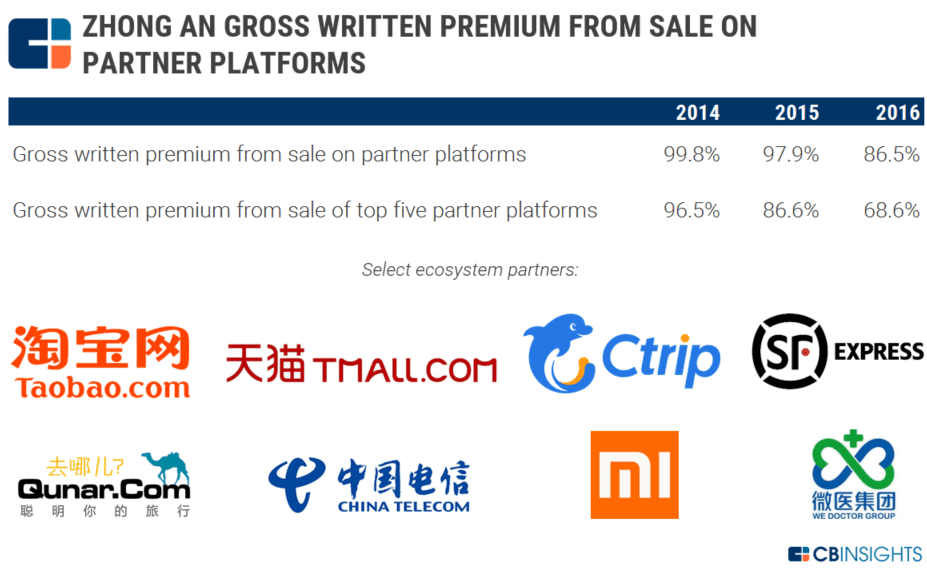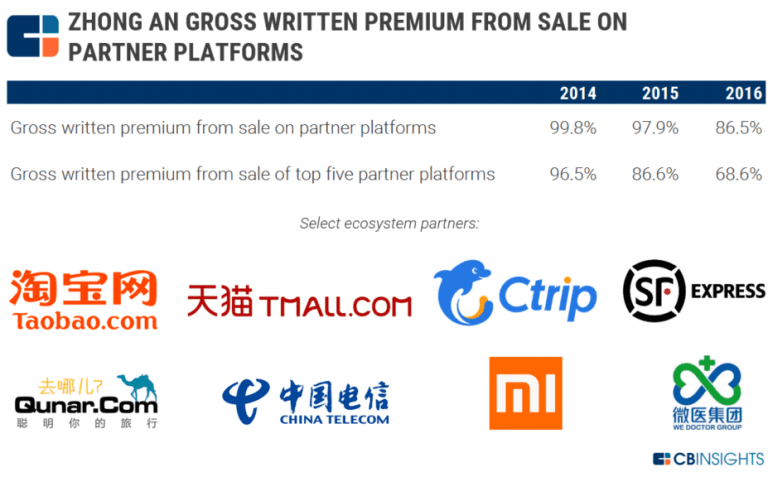The leading Chinese online insurance company, ZhongAn Online Property & Casualty Insurance Co, started trading on the Hong Kong stock exchange earlier today. Its shares jumped to as high as HK$70.50 in early morning trading, compared with the HK$59.70 IPO price, before closing at HK$65.20, still an impressive 9.2% increase. The company raised US$1.5 billion in its Hong Kong IPO making it the largest IPO since April on that exchange.
ZhongAn’s IPO will likely make the company the 4th most valuable fintech company in the world with a market cap of about US$10.4 billion, following the top three fintechs, which are Paypal ($78bn), Ant Financial ($68bn) and Lufax ($18bn).
As the financial research firm Infocast estimated based on information from local brokers, applications for ZhongAn’s share offering last week attracted demand of nearly 400 times the number of shares on offer, which means ZhongAn might be the most popular IPO in the Hong Kong stock market for the past two years.
Peter Renton interviewed the CEO of ZhongAn Insurance, Jeffrey Chen, on the Lend Academy Podcast over the summer. Jeffrey said in the interview that ZhongAn has 492 million insurance customers as of December 31, 2016. That is more than four times that of insurance giant AXA’s customer base (107 million, as of December 31, 2016). By this measure, ZhongAn truly is the world’s largest insurance company. And this is just a four-year old company!
Why ZhongAn is So Succesful
As I see it, the core competencies of ZhongAn lie in its application of cutting-edge technology and its strong ties with internet companies.
For the technology part, ZhongAn has been using artificial intelligence and big data analytics in each step of the insurance value chain, from marketing, underwriting, pricing to claims processing.
The Financial Times reported that by using artificial intelligence and big data technology, ZhongAn’s flight-delay insurance could price in weather factors in real time for policies sold just hours before departure time.
Another example is that ZhongAn has partnered with a Chinese automaker to develop internet of things (IoTs) and telematics solutions. Telematics devices can capture drivers’ behavioral data, which can be fed to algorithms using big data techniques to tailor product pricing to observed risk levels.
ZhongAn’s close partnerships with almost 200 of China’s leading internet companies is what differentiates it from other insurtech or insurance companies. The company’s flagship product is shipping return policies, which reimburse the cost of shipping when a shopper returns a product.
In ZhongAn’s early days, the revenue generated by shipping return policies accounted for almost 90% of the total revenue. This product would not have been such a success were it not for its partnership with Alibaba. Ant Financial, the financial affiliate of Alibaba, is also the single biggest shareholder (16.04%) of ZhongAn.
Later on, ZhongAn expanded its product scope from e-commence to the whole internet ecosystem, including online travel agencies, mobile healthcare apps, cellphone manufacturers, logistics companies, you name it.

Typically, ZhongAn’s insurance plans cost less than a few dollars – sometimes even a few cents – so when you are deciding whether to buy it, it just costs too little to hesitate, and it happens to help cover your risk in a specific scenario.
For example, one who purchases flight tickets online would be directed to purchase various insurance options including ZhongAn’s flight accident or flight delay policies; one who purchases a cellphone online could be directed to ZhongAn policies that cover phone loss. They call these innovative ecosystem-oriented insurance products “scenario-based policies”.
But the market sometimes has different perspectives on the partnership model. Emperor Capital, the Hong Kong-based brokerage house, on September 18 published a research report (in Chinese) about ZhongAn Insurance, commenting that in 2017 Q1 ZhongAn incurred a net loss, and it is mainly attributed to the significant rise in “consulting fees and service charges”, policy reserves and R&D expenses.
“Consulting fees and service charges” refers to the money ZhongAn pays its partners for customer introductions and commissions. In 2014, 2015 and 2016, the “consulting fees and service charges” accounted for 13.3%, 30.7% and 33.9%, respectively, of the net premiums.
Yet ZhongAn has been trying to diversify its distribution channels and that has worked out a little: the Gross Written Premiums, or GWP, generated from the sales on the platforms of ZhongAn’s ecosystem declined form 99.8% in 2014 to 86.5% in 2016.
The China Internet Boom
When we talk about ZhongAn’s success, we always talk about how sophisticated it is with the technologies, and how it is well embedded in the internet ecosystem, and how powerful its backers are (Ant Financial, Tencent and Ping An Group).
But the reason might go deeper than that: ZhongAn happens to be founded in the time when there was a boom of internet companies; cheaper cellular data and smartphones become accessible to the masses; people’s habits of making mobile payments have formed; and probably the large population base of China also helps.
All these reasons combined have made a lot of amazing fintech companies in China in the past five years. Some of them have been publicly listed offshore already: P2P platform Yirendai and China Rapid Finance have listed in NYSE, and ZhongAn is now publicly traded in the Hong Kong stock exchange.
We can foresee a few more to come in the near future: Chinese micro-lender Qudian has filed for its U.S. initial public offering; word has also come out that Beijing-based Quant Group will do its IPO in the U.S. Lufax and Ant Financial are considering IPOs in Hong Kong, according to Reuters, though the exact timing remains uncertain.


